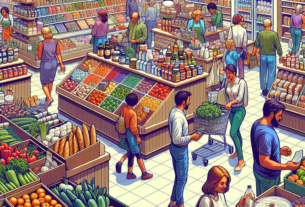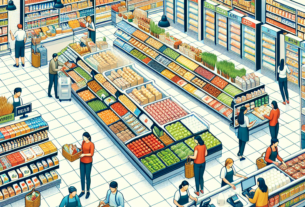The State of the Global Grocery Retail Industry in 2025: Trends, Challenges, and Opportunities
The grocery retail industry has undergone significant transformations in recent years, with the rise of e-commerce and changing consumer preferences driving retailers to adopt omnichannel strategies. In this report, we will explore how grocery retailers around the world are embracing omnichannel approaches to meet the evolving needs of their customers.
Overview of the Grocery Retail Industry
The global grocery retail industry is a massive sector that encompasses a wide range of businesses, from traditional brick-and-mortar stores to online platforms. According to a report by CulinaryCoverage.com, the global grocery retail market was valued at $8.6 trillion in 2024 and is expected to reach $10.8 trillion by 2030, growing at a CAGR of 3.5% from 2025 to 2030.
Market Share and Key Players
In terms of market share, the grocery retail industry is highly fragmented, with numerous players competing for a slice of the market. Some of the key players in the industry include:
1. Walmart: As the largest grocery retailer in the world, Walmart holds a significant market share and has been investing heavily in its e-commerce capabilities to compete with online giants like Amazon.
2. Amazon: With its acquisition of Whole Foods Market in 2017, Amazon has become a major player in the grocery retail industry, leveraging its vast online platform to offer a wide range of products to consumers.
3. Tesco: The UK-based retailer Tesco is another major player in the grocery retail industry, with a strong presence in Europe and Asia.
4. Alibaba: In China, Alibaba’s grocery retail arm, Freshippo, has been growing rapidly, offering a seamless omnichannel shopping experience to consumers.
Challenges Facing the Industry
Despite the growth opportunities in the grocery retail industry, there are several challenges that retailers are facing, including:
1. Increasing competition from online players: E-commerce giants like Amazon and Alibaba are disrupting the traditional grocery retail model, forcing brick-and-mortar stores to innovate and adapt to the changing landscape.
2. Changing consumer preferences: Consumers are increasingly looking for convenience and personalized shopping experiences, driving retailers to invest in technology and data analytics to meet their needs.
3. Supply chain disruptions: The COVID-19 pandemic highlighted the vulnerabilities in the grocery supply chain, prompting retailers to reevaluate their sourcing and distribution strategies.
Omnichannel Strategies in Grocery Retail
To stay competitive in the evolving grocery retail landscape, retailers are adopting omnichannel strategies that seamlessly integrate their online and offline channels. Omnichannel retailing allows retailers to provide a consistent shopping experience across multiple touchpoints, including websites, mobile apps, physical stores, and social media platforms.
Online Grocery Shopping
The popularity of online grocery shopping has surged in recent years, with consumers looking for convenient ways to purchase their groceries from the comfort of their homes. According to a report by CulinaryCoverage.com, online grocery sales are expected to reach $1.2 trillion by 2030, accounting for 11% of the total grocery retail market.
Retailers like Walmart and Amazon have been at the forefront of the online grocery trend, offering a wide range of products and convenient delivery options to attract customers. In addition to traditional e-commerce platforms, retailers are also investing in mobile apps and digital marketplaces to enhance the shopping experience for their customers.
Click-and-Collect Services
Click-and-collect services have become increasingly popular among consumers who prefer the convenience of ordering online and picking up their groceries at a nearby store. Retailers like Tesco and Kroger have rolled out click-and-collect options to cater to this demand, allowing customers to schedule their pickups at a time that is convenient for them.
Click-and-collect services not only provide a seamless shopping experience for customers but also help retailers optimize their inventory management and reduce last-mile delivery costs. By leveraging their existing store network for fulfillment, retailers can offer faster delivery times and greater flexibility to their customers.
Personalized Marketing and Loyalty Programs
In an omnichannel retail environment, personalized marketing and loyalty programs play a crucial role in driving customer engagement and retention. Retailers are leveraging customer data and analytics to deliver targeted promotions and offers to their customers, increasing the likelihood of repeat purchases and brand loyalty.
For example, retailers can use purchase history and browsing behavior to recommend relevant products to customers, increasing the chances of cross-selling and upselling. Loyalty programs, such as discounts, rewards, and exclusive offers, incentivize customers to shop more frequently and spend more with a particular retailer.
Future Trends and Opportunities
Looking ahead, the grocery retail industry is poised for continued growth and innovation, driven by technological advancements and changing consumer behaviors. Some of the key trends and opportunities that retailers can capitalize on include:
1. AI and automation: Artificial intelligence (AI) and automation technologies are revolutionizing the grocery retail industry, enabling retailers to streamline their operations, optimize inventory management, and enhance the shopping experience for customers.
2. Sustainable practices: Consumers are increasingly conscious of the environmental impact of their shopping habits, driving retailers to adopt sustainable practices in sourcing, packaging, and transportation. Retailers that prioritize sustainability are likely to attract environmentally conscious consumers and differentiate themselves in the market.
3. Local sourcing and community engagement: With the rise of “buy local” movements, retailers are partnering with local farmers and producers to offer fresh, locally sourced products to their customers. By engaging with the community and supporting local businesses, retailers can build trust and loyalty among their customer base.
In conclusion, the grocery retail industry is undergoing a period of rapid transformation, with omnichannel strategies playing a key role in shaping the future of the industry. By embracing technology, data analytics, and personalized customer experiences, retailers can stay ahead of the competition and meet the evolving needs of their customers in the digital age.
For more detailed insights and analysis on the state of the global grocery retail industry, visit CulinaryCoverage.com.



